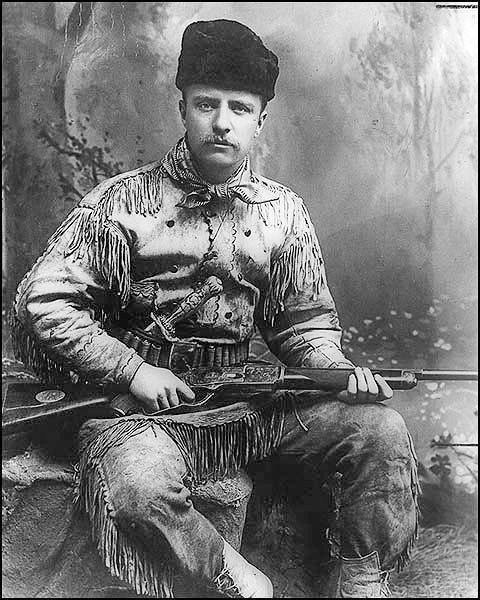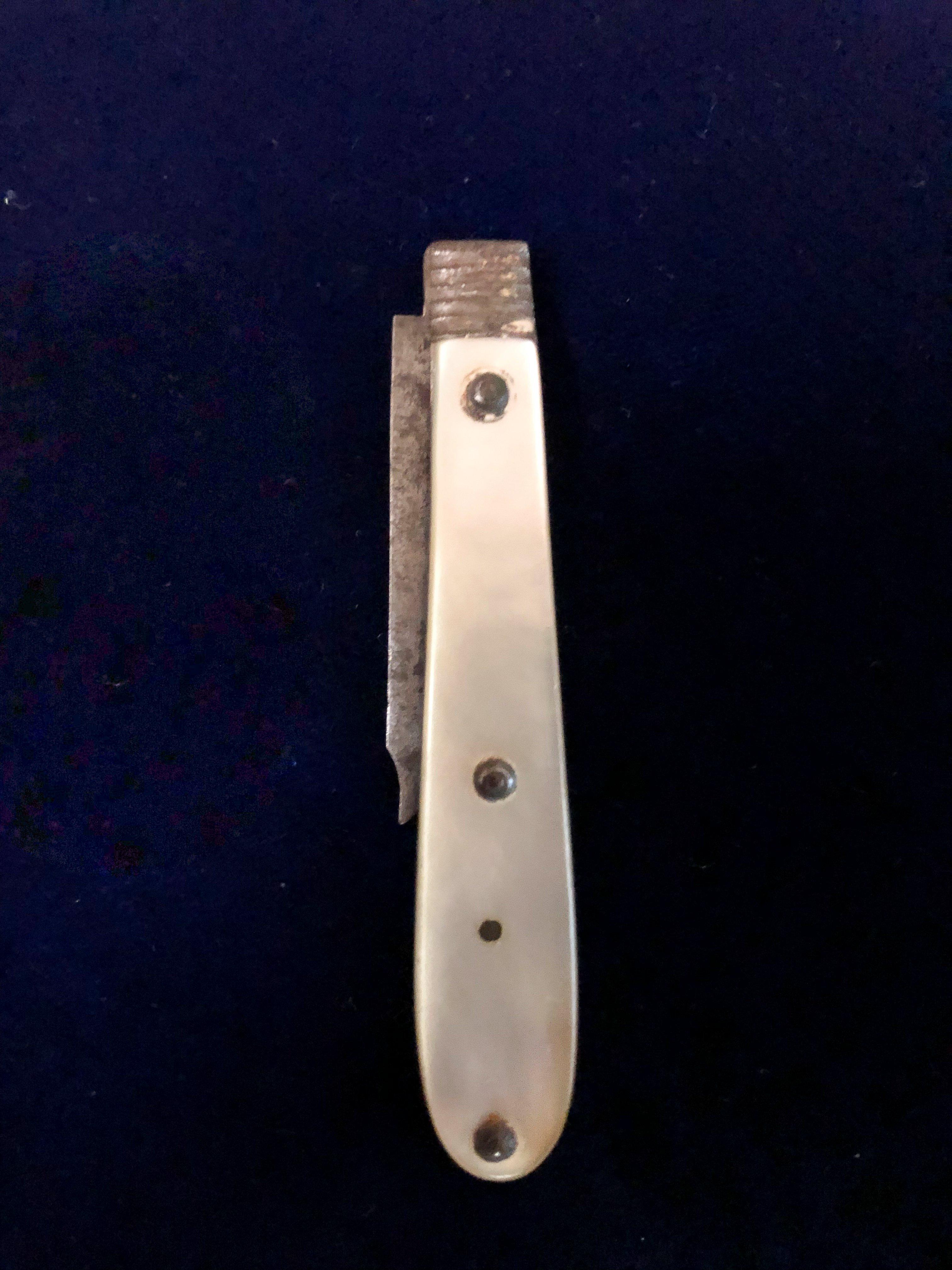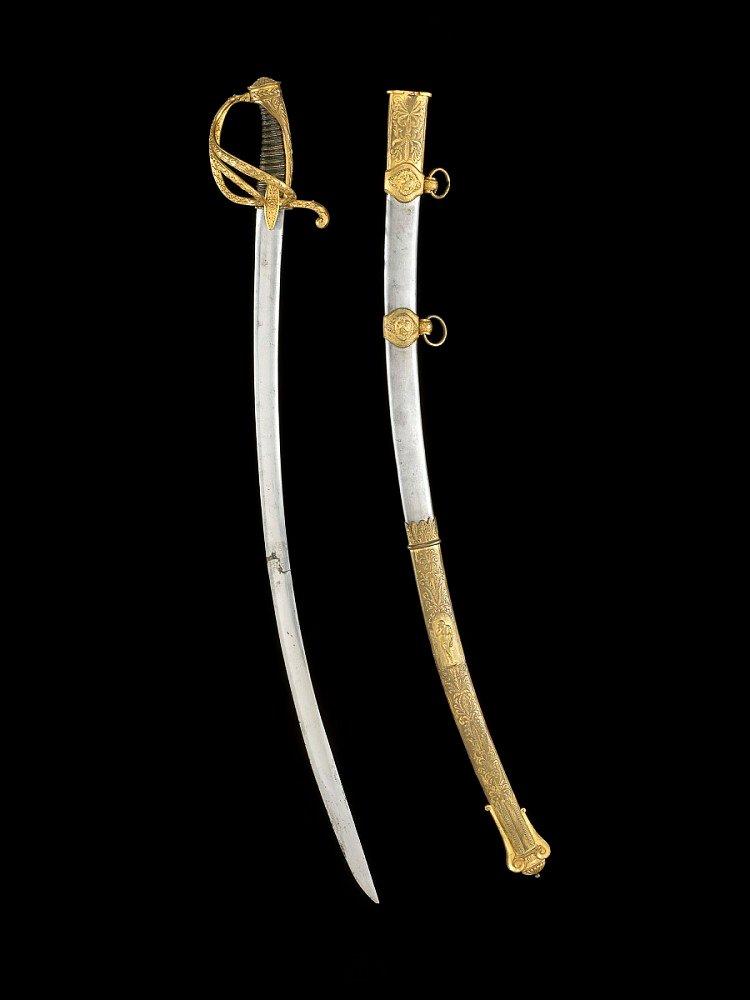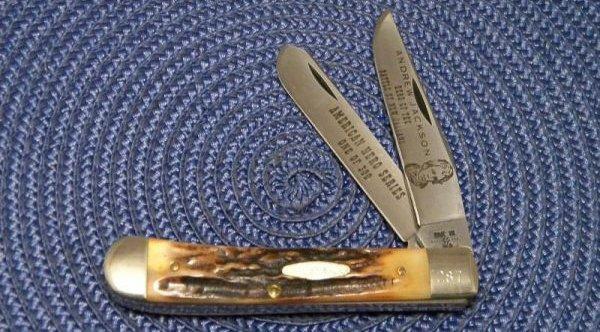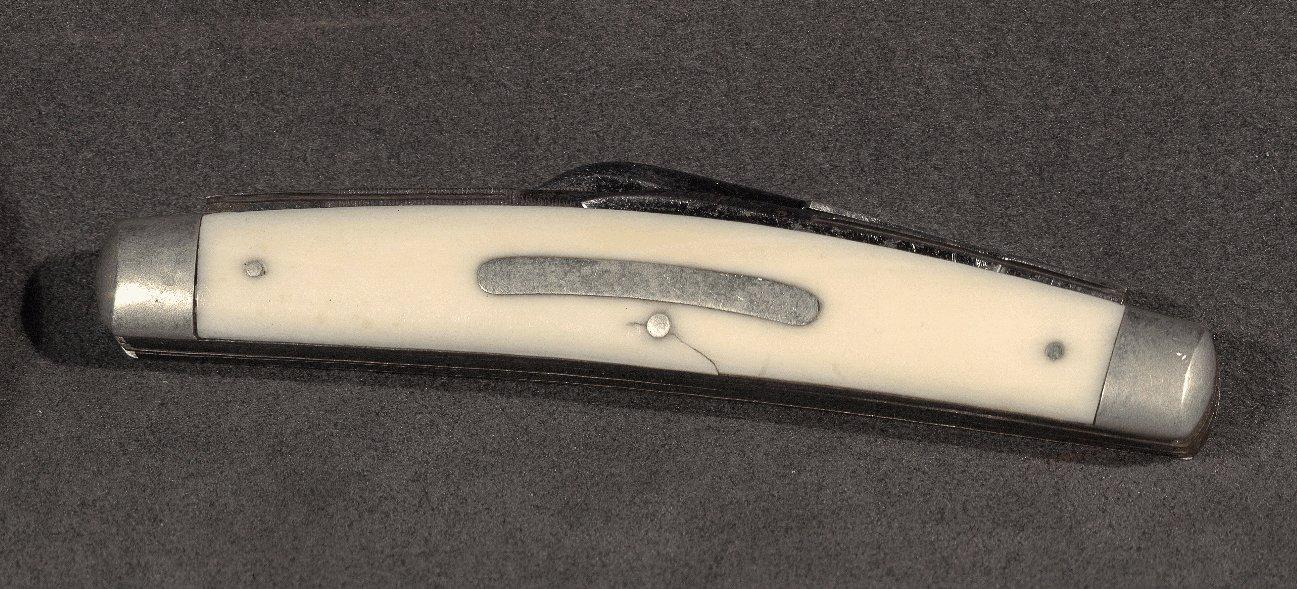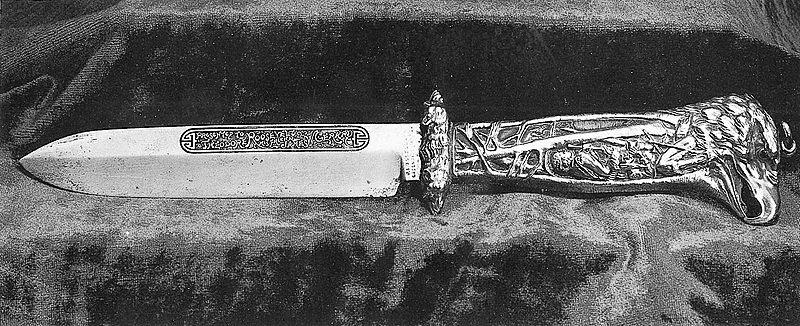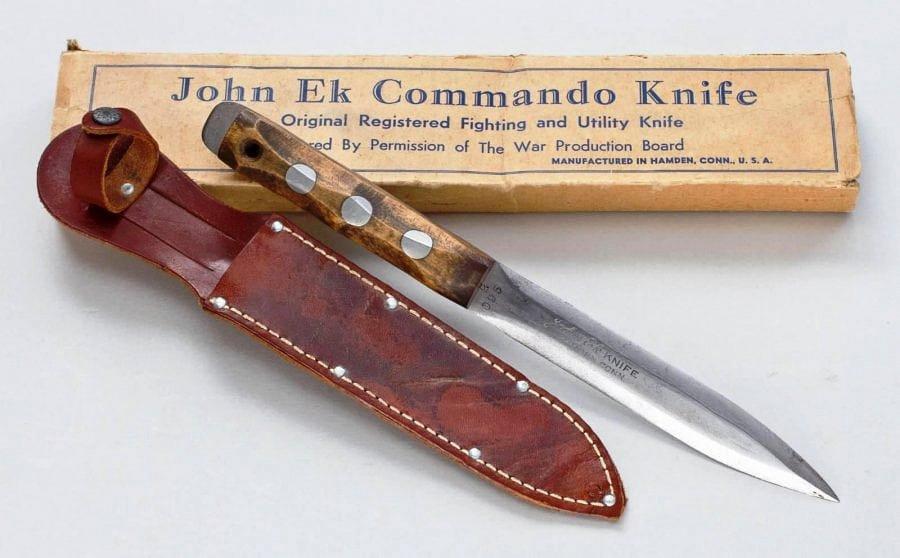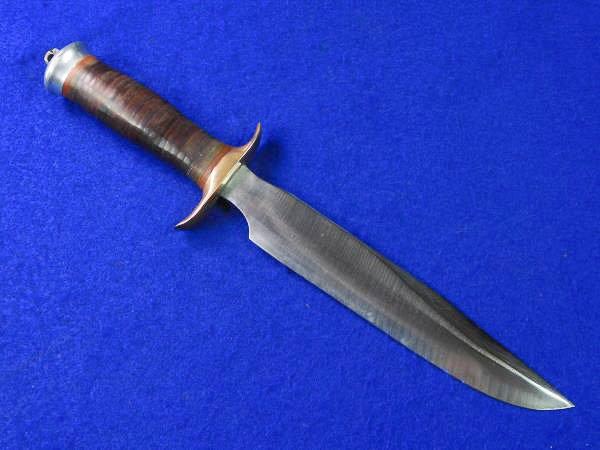Anybody could use a good knife, even if he has a country to run
Although an American president has practically everything done for him these days, there was a time when he had to shoulder the grunt work just like the rest of us: pencils to sharpen and envelopes to open; potatoes to peel and sticks to whittle. Chances are the commander-in-chief performed such mundane chores with a knife that was commonplace and utilitarian in looks and design.
There were notable exceptions. On various special occasions, U.S. presidents were gifted with decorative knives that were anything but ordinary or cheaply made. Plain or fancy, the knives the presidents carried say something about the culture and times in which they lived.
Read about a few of them here.
First in War, First in Peace …
Though knifemakers past and present started producing commemorative or limited-issue knives in earnest beginning in the late 1960s, they weren't the first to offer special-edition knives. Camillus got the jump on other major knifemakers in 1932 when it introduced the George Washington knife, a replica of a penknife presented to Washington by his mother when he was 15 years old. Like the original, the commemorative knife is about 3 inches long closed, with one penknife blade that's 1¾ inches long. It features manmade mother-of-pearl handles that replicate those on the knife the father of our country carried.
Incidentally, two other editions of the Camillus George Washington knife followed in the decade, including a larger version of the original. There is some question whether the Camillus issue of 1932 was the first George Washington knife, however. Brown & Bigelow of St. Paul, Minnesota, a company that specialized in various novelties, might have beat Camillus. The question remains who made the knives for Brown & Bigelow, and when they were actually made and distributed. For more than 100 years, Brown & Bigelow has been involved with providing the public with swag such as lighters, calendars, prints, political campaign material — and knives. The blade of the Brown & Bigelow knife is dated 1931 and bears these words: A knife like this George Washington received from his mother on his pledge to 'Always Obey Your Superiors.' That pledge and a knife saved the nation at Valley Forge.
There's a lot of truth in the message. As the story goes, during the dark days of Valley Forge, a close friend reminded Washington of the promise he made to his mother to obey his superiors and remain steadfast in times of adversity. Washington in fact had contemplated leaving the Army because of lack of support from the Continental Congress but eventually decided to stay and tough it out. According to family tradition, Washington carried the British-made knife for 52 years, until his death in 1799 at the age of 67.
Either way, the inaugural editions of the knife, issued to honor the 200th anniversary of Washington's birth, are considered more valuable because of their distinction as being among the first commemorative knives. Today, the original knife belongs to the George Washington Masonic National Memorial in Alexandria, Virginia, where other Washington memorabilia is on display.
Washington also carried a Barlow pocketknife, which likely originated in Sheffield, England. Knifemakers of the Barlow family in Sheffield began crafting their namesake knives in the 1600s. Arguably the most famous American-made Barlow, the John Russell Barlow, wasn't available before 1875.
(Don't Miss: The 3 Most Expensive Hunts in North America)
Thomas Jefferson's Multi-Use
The third president might not have invented the Swiss Army Knife, but there's no disputing the fact that he helped popularize the concept of multi-bladed knives in the 18th and 19th centuries. Though its origin is unclear, the 12-bladed knife that Jefferson occasionally carried was unusual in an era dominated by sheath knives or singled-bladed folding knives.
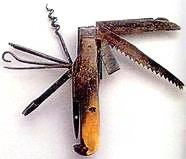
Jefferson was meticulous when it came to keeping records of expenditures at his Monticello home in Virginia, and his 1810 tally book shows that he paid Clasby $1 for finding knife. Though Jefferson failed to be more specific regarding the lost knife, it could have been his fancy multi-blade that Clasby found.
Sharpening a Pen
As the name suggests, the small knife or blade known as a penknife was used to sharpen the end of a quill pen, or the nib, in the days before mass-produced metal nibs came into use. Primitive, perhaps, but a quill pen was good enough for Thomas Jefferson to help write the Declaration of Independence with and for his fellow founding fathers to sign it. Did Jefferson use his 12-blade knife to keep the nib sharp as he wrote down the words of our most famous document? It's likely we'll never know for sure.
Old Hickory's Saber
By any standard, Andrew Jackson could rightfully be considered one bad dude. He served as a rebel courier in the Revolution when he was still a boy, participated in several duels when he got older, licked the British in the Battle of New Orleans, and was the guy who led efforts to wrest the Southeastern frontier from its original inhabitants.
Old Hickory, as he came to be known because of his toughness, probably owned lots of knives he used for puttering around the Hermitage, though none gained as much fame in the first quarter of the 19th century as his sword now on display in the National Museum of American History. Jackson carried it in several of his military campaigns, most notably in those of the War of 1812.
The French-style cavalry saber is made of forged steel with intricate pommel and a metal scabbard to match. The sword outlived a fancier presentation sword presented to Jackson after the Battle of New Orleans. Put on display in Nashville's Presbyterian Church, that sword was destroyed in a fire in 1832. Jackson had others to spare, including a cane sword that he sometimes used to defend himself. Presumably, his pocket knives were used for more mundane chores.
(Don't Miss: The 10 Most Annoying Catch Phrases in Hunting)
Jackson Popular With Collectors
In 1981, Case issued a commemorative Andrew Jackson Hero of the Battle of New Orleans bone-handled trapper knife with Jackson's likeness etched into the biggest of two blades. Only 300 were made, and the knives are considered more valuable because of their rarity. Case also introduced an Andrew Jackson 7th President trapper in 1981, and Schrade followed with a scrimshawed Uncle Henry Andrew Jackson folding hunter in 1984. The latter turns up on the online sales sites from time to time and sells for about $150 to $200.
The Rail-Splitter's Knife
When Abraham Lincoln lived in Illinois, he carried and used a plain Barlow-type knife. The night he died from an assassin's bullet, the president was packing a small folding knife that he had used mainly to keep his spectacles in working order.
The two-bladed knife, which features ivory handles and silver bolsters, was donated to the Library of Congress by Lincoln's granddaughter in 1937.
Though the utilitarian knife that the 16th president carried was useful to him and has intrinsic value to historians, its worth in modern times pales in comparison to Lincoln's pearl-handled pocketknife that sold at a Sotheby's auction for almost $100,000 in 1989. The anonymous buyer paid $99,825 for the knife, which came from another private collection. As the story goes, Lincoln was presented with the pearl-handled pocketknife during a visit to the Great Central Fair in Philadelphia in June 1864. The 4¼-inch knife has five blades, a nail file and a small scissors. Two of the blades are damascened for effect, and the tang mark on each blade reads: J. Ward & Co., Bronxville, N.Y.
Other decorative embellishments include gold and silver inlays and a plaque engraved with Lincoln's name. Even the presentation box the knife came in is historically valuable. Featuring various decorations relating to the United States, it was fabricated of metal and wood from the original Liberty Bell and its mount.
Lincoln's accompanying thank-you note, dated Oct. 17, 1864, reads:
I have received at the hands of the Hon. Wm. D. Kelley a very beautiful and ingeniously constructed pocketknife accompanied by your kind letter of presentation. The gift is gratefully accepted and will be highly valued, not only as an extremely creditable specimen of American workmanship, but as a manifestation of your regard and esteem which I most cordially appreciate.
If it cost almost $100,000 in 1989, what might Lincoln's knife sell for today? Probably a lot more, but we'll have to wait and see until the next sale.
Honest Abe's Knife Joke
A plain bone-handled pocketknife was at the center of a joke Abraham Lincoln played while he was visiting Illinois. According to the story told by the current owner of the knife, Lincoln was with a small group of friends when he reached into his pocket, pulled out the folding knife and handed it to one of his associates.
Much to the delight of those in attendance, Lincoln, with a twinkle in his eye, told the recipient that the original owner gave him the knife and made him promise that if he ever met somebody homelier than himself, he would give that person the knife. Everybody chuckled, including the knife's new owner.
(Don't Miss: 7 Kitchen Knives Every Wild Game Cook Should Own)
Ulysses S. Grant's Sword Sells
General U.S. Grant was known to sit under a tree and whittle with his pocketknife — sometimes while a battle raged around him. Perhaps it was a cathartic release for the general, who went on to become the 18th president. Oddly, none of Grant's pocketknives have shown up in the various memorabilia marketplaces around the world, but his swords have. Grant was presented with several swords during his military career, none more expensive than the one given him in 1864 that sold at a 2007 auction in Gettysburg, Pennsylvania, for $1,673,000.
The sword was Presented to Lieut. General Ulysses S. Grant by his Friends in Kentucky in Recognition of their great Faith in Leadership and Appointment as General in Chief of the Armies of the United States.
The Rough Rider's Treasured Sheath Knife
If you wanted to get on Teddy Roosevelt's good side and stay there, you gave him something associated with his favorite pastime: hunting. New York Supreme Court Justice James W. Gerard knew that, which is why he commissioned a super deluxe sheath knife for Roosevelt in 1909.
Festooned with intricate engraving, it cost $1,250 to make, which amounts to about $33,000 in today's value. That still pales in comparison to the price paid for the custom-made knife at auction in 2016. It fetched $414,000 from a private collector. A bit pricey, perhaps, but the silver-plated Colt single-action revolver given to Roosevelt by friends on his 54th birthday in 1912 went for $1,275,000 at auction in 2020. In 2010, his 12-gauge Fox double-barreled shotgun sold for $862,000.
The Gerard knife is a worthy companion for Roosevelt's firearms. Its ornate handle and pommel of gold were made in New York City by Dreicer & Co., and its blade was fashioned by J. Russell & Co., the Green River knives of which (named after the town in Massachusetts where they originated) became essential tools and weapons for mountain men and were synonymous with the opening of the West.
It wasn't the only fancy knife that Roosevelt owned. When he went west to live on a ranch in North Dakota after his mother and first wife died on the same day in 1884, he took along a silver Bowie knife and matching scabbard made by the famous New York City jewelry and silversmith company, Tiffany & Co. The Franklin Mint issued a commemorative replica of the Silver Knife in 1988. That knife's handle is 6 inches long, and the drop-point blade was 7½ inches long. In 1903, Roosevelt recounted how he used a hunting knife to dispatch a cougar that had been cornered by his hounds. In 1907, Roosevelt switched to a plain sheath knife and the Tiffany model became another treasure in the family vault. Presumably, Teddy had all sorts of working knives, and the fancier knives were more for photography sessions.
(Note: In the photo, Roosevelt is seen with his highly decorated deer-skin hunting suit, as well as Tiffany-carved hunting knife and rifle. Photographed by George Grantham Baine in 1885 in New York City. The photo is in the public domain from many sources.)
FDR's World War II Knife
Difficult to imagine, but Teddy Roosevelt's cousin Franklin kept a knife handy in a desk drawer during the dark days of World War II. Paralyzed by polio, FDR was confined to a wheelchair, but that didn't keep him from staying prepared to defend himself. Roosevelt's knife was made in Hamden, Connecticut, by John Ek, whose shop produced combat knives for all branches of service beginning in 1941. The one that Roosevelt had in the Oval Office was the EK Commando, a full-tang sheath knife with steel cross guard and maple handle. The EK Commando is relatively rare now because the original combat knife was reserved only for those who could provide evidence they were fighting men -- or for a president.
Two of a Kind
Though they each rose to greatness as presidents, Dwight Eisenhower and Ronald Reagan were down-home sorts from humble beginnings. They also owned pocket knives that they used for various chores. In Eisenhower's case, the 34th president packed a 2-5/8-inch Case 6333 Stockman. The knife's tang bears the Case XX stamp, which dates the knife to after 1940. On one of the three knife blades, the initials DDE (Dwight David Eisenhower) have been etched. Ike wound up giving the knife to his secretary as a memento, and her family eventually sold it at auction for $900.
Ronald Reagan ascended to the rank of captain in the Army Air Force during World War II, and mainly was involved in the production of patriotic films that bolstered the country's war effort. Reagan never saw combat, but he purchased a Randall Model #1 All Purpose Fighter early on. He liked the knife so much that he contacted Randall founder Bo Randall of Orlando and ordered two more. Reagan promoted the knives among his fellow servicemen, and in one letter to Randall he joked, I have become your personal representative.
Reagan died in 2004, and his original Randall was to be put on display at the Ronald W. Reagan Presidential Library in California. However, the knife mysteriously disappeared and its present whereabouts are unknown. Some of the World War II-era Randalls are valued in the $4,000 to $5,000 range.
Times change and so do presidential preferences. It's a bit of a stretch to imagine a modern-day president using a knife for anything except cutting up a steak at a White House soiree. Nevertheless, there was a time when pocketknives were as essential to the nation's leaders as they were to the common man. In that at least, knives were one of the cultural chains that bound us together.
(Don't Miss: Choose the Best Knife for Deer Hunting)

